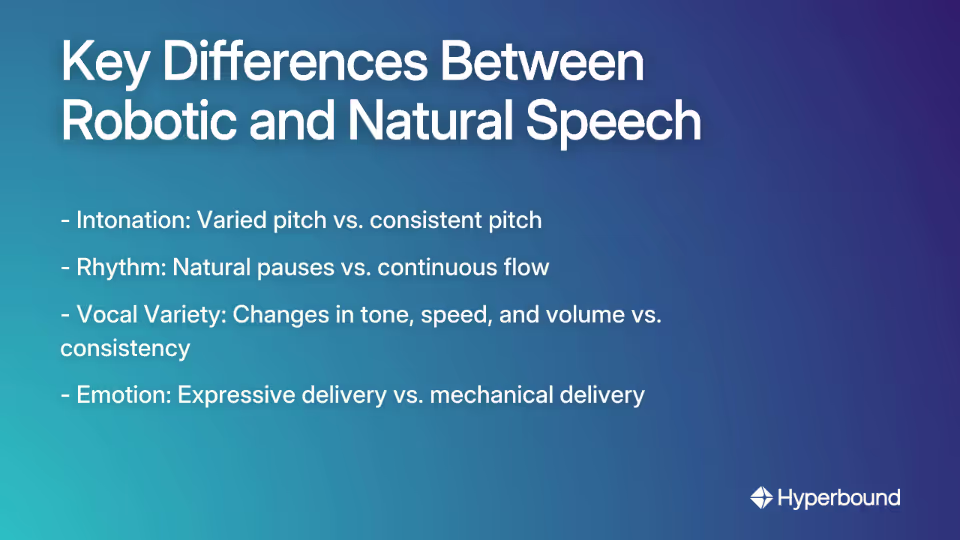
Have you ever listened to a recording of yourself and winced at how flat and robotic you sound? Perhaps you've been told your speech lacks expression, or you've noticed people's attention drifting as you speak. "My spoken English sounds really flat with no voice modulation or natural pauses, so it ends up feeling dull and robotic," as one person put it, capturing an experience many of us share.
You're not alone in this struggle. Many people find that their speech doesn't reflect their true personality or the richness of their thoughts. Whether from anxiety, limited practice, or simply never having learned the techniques, a monotone voice can become a barrier to connection.
The good news? A natural, expressive voice isn't an innate talent—it's a trained skill that anyone can develop with the right approach. Your voice is as unique as your fingerprint, capable of expressing a full range of emotions and nuances. The challenge is removing the barriers that prevent that natural expression from flowing.
In this article, we'll explore both the psychological roots of robotic speech and provide practical techniques to help you unlock your authentic voice—one that engages listeners, conveys your personality, and builds genuine connections.
Why Do I Sound Like a Robot? Understanding the Root Causes
Before jumping into solutions, it's important to understand why you might sound monotonous in the first place.
The Psychology Behind Monotonous Speech
Fear of Judgment: Many people retreat into a "safe," serious, and monotonous voice because they're afraid of being misunderstood or judged. As one person confessed, "I think I try to be too serious when I talk because I am afraid of people not understanding what I'm trying to say." This fear creates tension, limiting vocal expression.
Lack of Practice: If you've had limited social interaction throughout your life, your speaking skills may be underdeveloped. Many people report their sentences feeling "choppy and inadequate," as if their "mouth runs on autofill, using random words to quickly compensate." Without regular practice, conversational fluency remains elusive.
Self-Perception & Limiting Beliefs: The stories we tell ourselves ("I'm an introvert," "I freeze when speaking") shape our vocal delivery. These beliefs become self-fulfilling prophecies, reinforcing a monotone pattern that feels safe but unfulfilling.
The Anatomy of Robotic vs. Natural Speech
From a technical perspective, several elements distinguish robotic from natural speech:
Intonation and Pitch: Robotic speech maintains a consistent pitch throughout, while natural speech uses varied pitch to convey emotion and emphasize important words. This variation in pitch is what gives speech its musicality and expressiveness.
Rhythm and Natural Pauses: Human speech naturally incorporates pauses for breath, emphasis, and thought, creating a comfortable rhythm. Robotic speech often rushes forward without these vital breaks, creating an artificial, mechanical quality.
Vocal Variety: Natural voices vary in tone, speed, and volume depending on the content and emotion being expressed. Robotic voices maintain consistency regardless of what's being said, making the content feel flat and unimportant.

Unlocking Your Mind: The Psychology of a Natural Voice
Before addressing the physical aspects of speech, we need to explore the mental barriers that might be holding you back. Your mindset profoundly affects how your voice emerges.
Challenge Your Inner Critic
Many of us have an internal critic that scrutinizes our every word. This critical voice can paralyze our natural expression, leading to stiff, robotically careful speech.
Positive Self-Talk: Replace thoughts like "I sound terrible" or "Everyone will judge my accent" with constructive alternatives: "My unique voice adds character to my message" or "I'm improving with each conversation." This shift in self-talk can dramatically reduce the tension that constricts your voice.
Reframe Past Experiences: If you've been criticized for how you speak or had embarrassing moments, acknowledge these experiences but don't let them define your future. Each speaking opportunity is a fresh chance to connect, not a referendum on your worth.
Harness the Power of Visualization
Create a Mental Blueprint: Before important conversations or presentations, take a moment to visualize yourself speaking with confidence and fluidity. Imagine your voice carrying naturally, your words flowing with ease, and your audience responding positively. This mental rehearsal creates neural pathways that support actual performance.
Manage Speaking Anxiety
"Do It Scared": Accept that nervousness is normal, even for experienced speakers. The key is to speak despite the fear, knowing that each time you push through, your confidence grows.
Mindfulness & Breathing: Before speaking, take a moment to center yourself. One helpful recommendation is to "not be afraid to take a brief pause and breathe. Slow down your speaking so you don't run out of breath." This simple practice can ground you in the moment and reduce anxiety that leads to rushed, flat speech.
Assume Engagement: Shift your mindset to believe that your listeners are genuinely interested in what you have to say. As one wise speaker noted, "You aren't speaking to everyone, you are speaking to one person at a time." This perspective takes the pressure off and allows for a more intimate, natural connection.
Finding Your Physical Voice: Practical Exercises and Warm-Ups
Now that we've addressed the psychological aspects, let's explore specific exercises to physically develop your voice. Just as athletes train their bodies, speakers can train their vocal apparatus for better performance.

The 15-Minute Vocal Warm-Up Routine
1. Prepare Your Body & Breath
Start with gentle neck rolls and shoulder stretches to release tension. Then, practice diaphragmatic breathing:
- Place one hand on your chest and another on your belly
- Breathe deeply so that your belly expands while your chest remains relatively still
- Exhale on a controlled "hiss" sound, training breath support
This form of breathing engages your diaphragm, the muscle that powers strong, resonant speech.
2. Relax Your Jaw and Lips
Lip Trills: Make a "brrr" sound, vibrating your lips together like a motorboat. This releases tension in the lips and relaxes the voice.
Jaw Massage: Gently massage the hinge of your jaw to release accumulated tension that can restrict articulation.
3. Build Resonance and Range
Humming: Start with gentle humming at a comfortable pitch, then gradually slide up and down your range. This warms up your vocal cords with minimal strain.
The "NG" Sound: Practice making the "ng" sound as in "sing," feeling the resonance in your nasal passages. This helps develop forward placement of your voice for better projection.
Siren Sounds: Gently glide your voice from your lowest comfortable note to your highest and back down, mimicking a siren. This increases vocal flexibility and reduces monotony.
4. Improve Articulation and Clarity
Vowel Clarity Exercise: Chant "mee-may-mah-moe-moo" on a single note, focusing on enunciating each vowel clearly. This trains the tongue muscles and improves overall articulation.
Tongue Twisters: Practice classics like "She sells seashells by the seashore" to develop pronunciation and speech clarity. Start slowly and gradually increase your speed while maintaining precision.
Singing Through a Straw: This technique, popularized by voice coaches, teaches you to vocalize with less effort and reduces vocal strain—perfect for developing a more dynamic approach to speaking.
Addressing "Vocal Fry"
Many people speak in their lowest vocal register, known as "vocal fry," which can contribute to a monotonous sound. The siren exercises above help move your voice out of this register, bringing more energy and expression to your speech.
Bringing It All Together: Techniques for Everyday Conversation
With your mind and voice warmed up, you're ready to apply these skills in real-world conversations.
Practice Makes Progress
Record Yourself & Use AI Feedback: One of the most effective self-assessment tools is recording yourself speaking. For even greater insight, AI practice platforms like Hyperbound allow you to roleplay conversations and get instant, objective feedback on your tone, pace, and clarity. When reviewing recordings, listen with a supportive, analytical ear, noting where your voice falls into monotony or where you use filler words excessively.
Read Out Loud: Several people found success by "practicing reading prose at home as if they were acting." One person even shared, "When I was younger, I read full books to my cat. It really helped me with speaking out loud." This builds fluency without the pressure of an audience.
Shadowing: This powerful technique involves listening to a short clip from a show, podcast, or speech you admire, then mimicking the speaker's tone, pauses, and stress patterns. One recommendation is to "start shadowing short clips from YouTube or Netflix, literally pausing, repeating, mimicking tone, pauses, and stress." This trains your ear and mouth for natural rhythm and flow.
In-the-Moment Strategies
Slow Down: Most robotic speech comes from rushing. The average conversational rate is around 135 words per minute, but many anxious speakers race well beyond this. Consciously slow your pace to give your words weight and yourself time to think.
Master the Pause: As one speaker wisely noted, "Use pauses to make important things stand out." A strategic pause is much more powerful than filling the space with "um" or "like." Pauses give listeners time to absorb your message and give you a moment to gather your thoughts.
Avoid "Up-Talk": This is the habit of ending statements with a rising inflection, making them sound like questions. Practice keeping your tone declarative when making statements to sound more confident and authoritative.
Add a Touch of Pizzazz: Don't be afraid to let your dry humor or personality shine through. Acting out scenes when telling stories or using your hands expressively can add dimension to your speech and make you more engaging.

Seek Supportive Environments
For those looking to leverage technology for rapid improvement, AI coaching platforms like Hyperbound offer a powerful solution. They provide AI-powered roleplays that allow you to practice critical conversations in a safe, repeatable environment and receive immediate, data-driven feedback on your vocal delivery. This offers a scalable way to build confidence and hone your skills on your own schedule.
Consider joining a group like Toastmasters where you can practice public speaking in a structured, supportive environment. Many have found that regular 1:1 coaching or interactive practice in such settings accelerates their progress dramatically.
The Natural Voice Network promotes community singing and workshops that are inclusive and focus on building confidence—another excellent resource for those looking to develop their voice in a supportive setting.
The Journey, Not the Destination: Embracing Your Authentic Voice
Remember that developing a natural voice isn't about perfection—it's about connection. As one person wisely noted, "It's a trained skill. Not something that comes natural to many." Be patient with yourself as you practice.
Your unique voice, with its particular timbre and qualities, is part of what makes you distinctively you. The goal isn't to sound like someone else, but to remove the barriers of fear and habit that prevent your authentic voice from emerging.
By combining psychological insights (speaking with intention) with physical techniques (developing vocal flexibility through exercises), you can transform a robotic delivery into a voice that engages, connects, and expresses your true self with confidence.
After all, clear speech is about two fundamental elements: enunciation and intention. Master these through consistent practice, and you'll find your voice becoming an asset rather than an obstacle in your personal and professional life.
Your natural voice is already within you—these tools simply help you unlock it.
Frequently Asked Questions
Why do I sound robotic when I speak?
You likely sound robotic due to a combination of psychological factors, like fear of judgment, and physical habits, such as a lack of vocal variety and unnatural pacing. It's often a learned pattern rather than a permanent trait. This article details how anxiety can cause tension that restricts your vocal range, while limited practice can lead to an underdeveloped conversational rhythm.
How can I stop my voice from sounding monotone?
To stop sounding monotone, focus on practicing vocal variety through exercises like pitch glides (sirens), varying your speaking speed, and using strategic pauses. This involves both physical warm-ups to increase your vocal range and conscious effort during conversations to add expression. The article provides a 15-minute warm-up routine that includes breathing, resonance, and articulation exercises to help you develop a more dynamic voice.
What is the fastest way to improve my vocal delivery?
The fastest way to improve your vocal delivery is through consistent practice with feedback. Recording yourself and using AI-powered practice tools like Hyperbound can provide immediate, objective insights into your tone and pacing. This allows you to identify and correct monotonous patterns much quicker than practicing alone. Shadowing—mimicking expressive speakers—is another highly effective technique for rapid improvement.
Can vocal warm-ups really make my voice sound less flat?
Yes, vocal warm-ups are highly effective for making your voice sound less flat. Just like stretching before exercise, warm-ups prepare your vocal cords, release tension in your jaw and lips, and improve your breath support. This enables greater vocal flexibility, allowing you to access a wider range of pitches and tones, which directly counteracts a flat, monotonous delivery.
How does speaking anxiety affect my voice?
Speaking anxiety directly contributes to a robotic voice by causing physical tension. This tension can constrict your throat muscles, lead to shallow breathing, and make you speak faster with a higher, flatter pitch. To combat this, the article suggests mindfulness techniques, deep breathing exercises, and shifting your mindset to focus on connection rather than perfection.
What is "shadowing" and how does it help with natural speech?
Shadowing is a technique where you listen to a fluent speaker and repeat what they say in real-time, mimicking their intonation, rhythm, and pauses as closely as possible. It helps you develop a more natural-sounding speech pattern by training your ear to notice nuances and your mouth to replicate them, effectively bypassing the robotic habits you may have developed.
Is it possible to improve my voice if I'm an introvert?
Absolutely. Improving your voice is a trainable skill, completely separate from being an introvert or extrovert. Many introverts are excellent speakers. The key is to practice in low-stakes environments, such as reading aloud or using AI roleplay tools, to build confidence before applying your skills in social situations. The techniques in this article are designed to build skill and confidence regardless of your personality type.
Note: If speech issues persist despite practice, consider consulting a speech-language pathologist who can provide personalized guidance and exercises tailored to your specific needs.

Book a demo with Hyperbound
.png)













